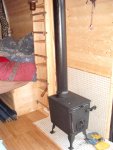Hi Robmac
Should be easy to rig a slow feed in and an outflow pipe but I am not sure what a long flue would do to the draft. Might turn it into a bit of a blow torch. Huge amount of heat output and fuel demand. If I can find a bit of suitable pipe for a flue, I will try it with mine
Richard
I see what you mean about the draft being too much, those things can fair roar when they get going.
But (I was going to write "So" but someone doesn't like sentences which start with "So", can't remember who, but there's a whole thread on it) what about covering the bottom (firepit) part of the storm kettle set up with some sort of thin grill (like you get on disposal barbeques_ so that there is a slight gap between the kettle part and the base part, so breaking the vacuum effect slightly - the same concept as having the door open on a wood burner - it doesn't burn as well as it does when the door is shut.
With regard to connecting the flue to the chimney and not being able to empty / fill water, my idea was that the end of the flue would have a sliding collar which would drop down over the top of the storm kettle chimney, and which could be pushed back up the flue so that the kettle part could be slid out off the firepit to empty and fill. Of course, this would mean that the open firepit part of the kettle would be completely open and may smoke out into the van but...
1. there may still be enough draw in the flue to draw the smoke from the open firepit up the flue
2. its easy enough to regulate the burn of the storm kettle as it needs feeding regularly so once it reaches boil point, it dies down very quickly if not refuelled immediately so its just a case of getting used to it and judging how much fuel to give it once it starts getting close to boiling point
3. a flat metal plate could be placed over the firepit when the kettle is removed and within a few minutes it would probably go out. If refilling the kettle with water, the metal plate would just be put on for the duration of the refill process, but it could be used to keep a kettle of water hot whilst extinguishing the fire.
I might be talking gibberish here as I dropped physics age 13 as I was rubbish at it, and have no clue with regards to the how and why things work (still struggling with understanding 12v elecs), but I'm really keen to follow this idea up partly because it would solve my problem perfectly, and also because if it works and the manufacturers like the idea (and why shouldn't they? It's a whole new market for them!) I might get royalties if I slap a patent on the idea or claim intellectual copyright pretty sharpish! (Of course, I know I've just shot myself in the foot for posting the idea here :scared: )
Keep me posted on your efforts TBear.
Tony Lee - definitely agree regarding both smoke and CO alarms, I have both and I know they both work cos they were tested not long ago when I was experimenting with my Tranjia stove inside the van - mistake! But I've had my camping gas stove on as a heater for up to an hour on the odd occasion without the CO alarm going off, but I do have an open vent in the roof. Some advice re location would be good though as I'm not sure where in the van it should be - I wondered about putting it at floor level as CO is heavy and I wouldn't want the dog to get gassed before the alarm went off. At the moment it's about waist height when standing in the van, but that's well above head height when I'm asleep. Suggestions?


